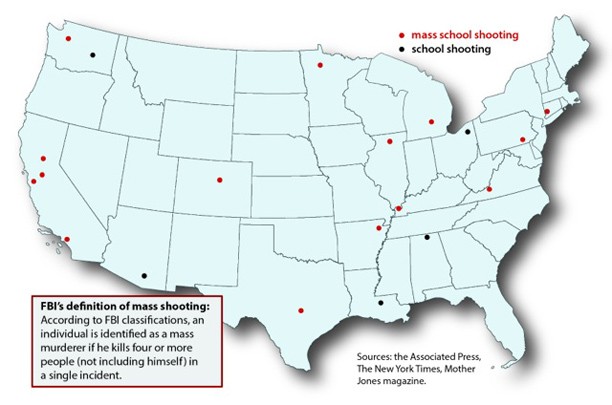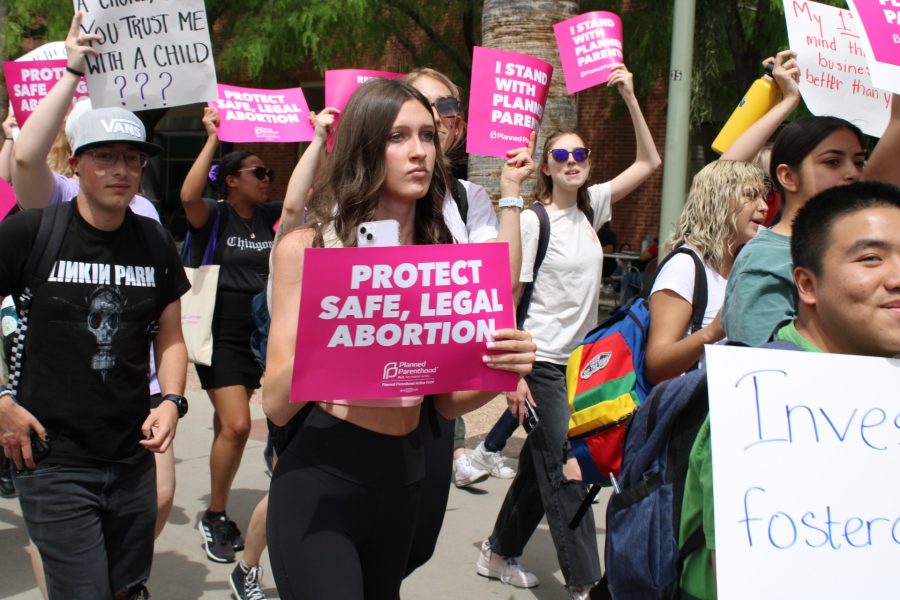You’re on your way to class, flipping through dog-eared psychology notes as you cram for your first exam of the semester. How could you have forgotten about the test? You know your professor mentioned it at least three times last week, but here you are, frantically reviewing last week’s notes as you dodge a blur of bikers on your way to class.
You break into a brisk jog to make it on time. Wiping the sweat from your forehead, you swing open the door of the Harvill Building and slip into an empty seat in the lecture hall. You wave at your friend, Kim, in the second row and reach for the zipper on your backpack. But your hand doesn’t make it there before the shots ring out.
Bang! Bang! Bang! The insignificant stresses of tardiness and tests evaporate as the screams of your peers, your friends and your professors fill the air around you. Someone is shooting. You are trembling, petrified, and you don’t know what to do. What happens next?
No one should have to answer this daunting question, but in recent years, it has become apparent that precautionary measures need to be taken on school campuses.
In 1999, at Columbine High School in Littleton, Colo., two armed students took the lives of 13 people and then their own. This massacre was one of the first school shootings that resulted in the loss of life on such a drastic scale, but, unfortunately, it wasn’t the last.
In the next decade, a student killed 32 people before committing suicide at Virginia Polytechnic Institute and State University in 2007, a 43-year-old man killed seven people at Oikos University in April of 2012, and, most recently, the Sandy Hook Elementary School tragedy resulted in the death of 26 people total, 20 of them children, in Newtown, Conn., last December.
The UA experienced this kind horror firsthand when the College of Nursing shooting occurred in 2002, a tragedy that resulted in the death of three teachers and the shooter’s suicide.
No two incidents are the same, but sadness, horror and pain are common links between them all; these are tragedies that no university, institution or person should have to endure.
So, how would the story end?
The answer depends heavily on the protocol of the University of Arizona Police Department and the Campus Emergency Response Team. Both departments work together to ensure the safety of all students, employees, faculty and staff within the community.
A student’s first plan of action should be to ensure safety and call 9-1-1. Alexandria Yetter, a biomedical engineering freshman, reflected on what she would do if she witnessed a student with a gun on campus.
“I actually work in the union, and … I might feel uncomfortable and really wary of him. I would definitely report it,” she said. “This is an open campus, so anything can happen, but it’s about knowing your resources.”
Robert Sommerfeld, a UAPD commander with more than 27 years of experience, commented on the department’s rigorous preparation for events such as this one.
“For law enforcement, our top priority is to stop the threat, which would be the individual or the individuals with the firearm. We are going to rapidly deploy to that threat to stop [it]. That is our primary goal,” Sommerfeld said. “Next is the care of individuals who may be injured and investigation of the incident to determine why this happened. [We] hold them accountable for their actions.”
While officers work on gaining control of the situation and minimizing harm, other members of campus would be made aware of the situation at hand. The UA has a few key ways to keep students, faculty, staff and parents informed.
UAlert is the most efficient and timely way to receive notifications about critical incidents affecting any of the UA campuses, according to the CERT website. Students, faculty, staff and parents all have the option to register for this service to stay up-to-speed with on-campus happenings. UAlert has close to 20,000 followers.
Melissa Vito has served as the chair of CERT for more than five years. She commented on the importance of community awareness in the event of an active shooter’s being on campus and the usefulness of UAlert in keeping the community informed.
“The [system] is linked to e-mails that go out as soon as we hear of something, to let people know to stay away from a particular area of campus, and we will always send out a message when something is clear,” Vito said. “If there are other messages, we will use that text system. It’s a system that parents can sign up for so that news can reach beyond just our community.”
Steve Holland is the assistant vice president for Risk Management Services, a department that deals with insurance coverage if employees are hurt on the job or if there is property loss. While the department is not involved in the immediate response, they deal with cleaning up the scene to restore the building to functionality.
“We need multiple channels of information going out, and UAlert is one of those,” Holland said. “The way those alerts are worded is critical. The challenge is to get the message out and make sure that they act on the information in a responsible way.”
The CERT website will also feature information about an incident if the board feels that it could potentially concern, affect or harm students. There is also a policy committee in CERT that would decide if classes needed to be cancelled, depending on the circumstances.
“All situations like this are dynamic. There is not a set script for them,” Sommerfeld said. “We inform people of it quickly so that they are aware of it and can take proper protective actions, which could be anything from sheltering in place to fleeing the area.”
Depending on the scale of the incident, UA facilities could be utilized for various purposes, according to the Campus Emergency Response Plan. Buildings like the McKale Center, the Campus Recreation Center and residence halls could potentially be used as shelters. If circumstances required additional medical relief, Arizona Health Sciences Center and the Department of Veterinary Science and Microbiology, as well as Campus Health Service, would provide assistance and supplies.
Once students and their families have been made aware of the incident, community members are in a safe location and stabilized, and the shooter has been apprehended, the campus community would begin the process of restoring normalcy on campus. Both CERT and the UAPD would direct their attention to the future and determine the best way for the university to proceed.
“We hope to learn from it and to see if there is anything that could be done differently in the future to prevent that from happening again, and, ultimately, our goal is to return to normalcy and take care of survivors,” Sommerfeld said.
Counseling and Psych Services is available to aid students in their journey to overcome any stress following an incident such as this, Vito said. There is also a team that works through Life and Work Connections that is trained in critical incident stress management, which is a national protocol that aims to help people deal with trauma, she added.
While members of these departments have very strict rules and guidelines to navigate situations like an on campus shooter, they recognize that the uniqueness of each situation that makes it hard to plan for. Both the CERT and the UAPD hold meetings and drills to ensure that all precautionary measures are being explored.
CERT meets monthly to assess plans for events that could pertain to the UA campus in the future. It has representation from a number of areas across campus, including delegates from the computer center at University Information Technology Services, UAPD and the Dean of Students Office. Select students also attend to stay up to date on developing protocol.
The police department regularly trains in active shooter response, internally and externally. UAPD and the Tucson Police Department were the initial responders for the College of Nursing shooting in 2002.
Andrea Pineda, a family studies freshman, expressed her trust in and reliance on UAPD.
“I have them on my cell phone,” Pineda said. “I would immediately call them.”
Police train regularly with the surrounding agencies, including the Tucson Police Department, Pima County Sheriff’s Department and the Pima Community College Police Department, Sommerfeld said.
Officers discuss plans and do walk-throughs during table top exercises, and also participate in hands-on training. For example, when the Franklin Building was ready for demolition, active shooter training was conducted. The officers also participate in Simunition (training ammunition) training on a quarterly basis.
This is system makes the circumstances as realistic as possible so that first responders are prepared in case of a high-intensity incident.
Students should understand that the UA has countless procedures in place to keep community members safe, and they should take the time to learn about these procedures so they can know what to do in a situation like the fictionalized scenario. Holland spoke about the importance of those on campus protecting themselves by learning about these protocols.
“I think it is good for members of the community to make themselves aware of what these systems are and how they work,” Holland said. “Everybody has a class to get to, everybody has a paper to write, everybody has a project to finish, but they need to spend a little time thinking about this. It is important.”









